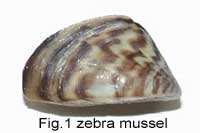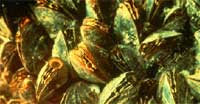|

the interesting local case of the zebra mussel
Invasion History
- zebra mussels (fig.1) Dreisenna polymorpha are not native to
North America but to the Caspian Sea, Black Sea, and Azov Seas of
Asia.
- the mussels then spread throughout Europe in
canals that were built in the 18th century.
- by the 1830s, mussels inhabited much of Europe
and Britain.
- zebra mussels are believed to have entered U.S.
waters when ballast (used to stabilize empty cargo ships on the ocean)
from a transoceanic vessel was discharged into Lake St. Clair, near
Detroit, Michigan, where they were discovered in 1986-88. Since
the, zebra mussels have spread to all of the Great Lakes and many inland
waterways in several states, along with Ontario and Quebec, Canada.
- billions of zebra mussels have reproduced and are
now hard to control.
Life History
view slide show of life history
 -
mollusks/gastropods/bivalves Dreisenna polymorpha -
mollusks/gastropods/bivalves Dreisenna polymorpha
- filter feed ambient waters for zoo/phytoplankton and suspended
detritus
- attach to substrate (rocks, pipes, boats, clams anything solid) using
byssal threads
- live in high density groups of many age classes
- age of first reproduction is very
young thousands of eggs produced per year throughout summer
- eggs and sperm meet in open water have high likelihoods of
fertilization
- offspring are planktonic (veliger larvae) and thus dispersal is
enhanced
- only a few predators eat Zebra mussels and none exclusively
- boaters and fisherman accidentally vector the adults on boats /
veligers in bait buckets
Effects on the ecosystem
 -
zebra mussels compete for substrate with other native mussels and
invertebrate populations -
zebra mussels compete for substrate with other native mussels and
invertebrate populations
- zoo/phytoplankton base of aquatic food chain is disrupted
- water column becomes less turbid allowing deeper
penetration of light which encourages weed growth in many areas where this
was not normal
- water pollutants are concentrated in feces, feces also harbor the
Botulinium toxin which has recently killed loons on Long Point
Lake Erie
- boats are fouled , water intake pipes for civic/industrial applications
are congesting
- they are here to stay, their populations have
imparted both good and bad qualities to the ecosystem
- hardyness, rapid maturity, high fecundity,
wide dispersal in larvae stage (veliger) and ability to adapt to new
environments have given the Zebra Mussel a high degree of fitness and
success as a species
|


 -
mollusks/gastropods/bivalves Dreisenna polymorpha
-
mollusks/gastropods/bivalves Dreisenna polymorpha -
zebra mussels compete for substrate with other native mussels and
invertebrate populations
-
zebra mussels compete for substrate with other native mussels and
invertebrate populations